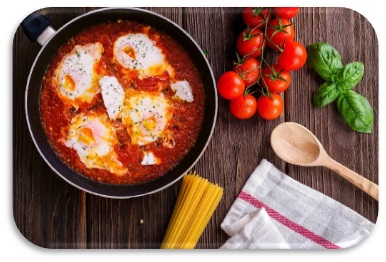With over 15 years of specialization in high volume fine dining and a life time of experience making delicious home cooked meals, Chef Will Made It is your trusted culinary professional.
The mother sauces are a group of five sauces from which numerous other sauces are derived. Mac and cheese? Made with mornay sauce, a derivative of bechamel – a mother sauce. Bearnaise sauce on a steak? Based on hollandaise, a mother sauce that’s famous in its own right. Tomato sauce? On its own, a mother sauce. The mother sauces are one of the first things new cooks should learn because they open the door to more complex techniques as well as better food and a deeper understanding of the culinary arts.
The five mother sauces are tomato, bechamel, velouté, hollandaise, and Espagnole. Any motivated cook can learn these sauces and use them to create delicious, impressive food right at home.
Tomato Sauce
Tomato sauce is the simplest mother sauce to make, requiring, at a minimum, oil, onions, garlic, tomatoes, and salt. There are many different ways to make tomato sauce, and many people will argue over which way is the best. The basic technique is simple: sweat the onions and garlic until soft and translucent, then add the tomatoes. Restaurants tend to use peeled, canned Roma or San Marzano tomatoes, which are crushed by hand or pureed in a blender. This will work fine for a home cook as well, but using canned, already-pureed tomatoes is an acceptable substitute.
Once added, the sauce needs to simmer for as long as possible, especially if crushed tomatoes are used. According to Chef Will Made It, this allows the acids and sugars in the tomato to a cookout, making the sauce more savory and less sweet. The salt can be added at any time, but earlier in the cooking process is optimal for flavor development. If the tomato sauce is too sweet or too acidic, more salt can be added at the end to correct it. There is no singular authority on tomato sauce, however, and many professional and home cooks will add fresh or dried basil, parsley, and oregano for flavor, sugar to offset acidity or tomato paste for added umami.
Bechamel
Bechamel sauce is arguably the most popular mother sauce because it is the first introduction many cooks have to make mac and cheese at home. The list of required ingredients is small: equal parts butter and flour, milk or cream or half and half, and salt. Traditionally, a whole onion spiked with cloves and a bay leaf is added for flavor, and while this does make for a delicious sauce, it is optional.
To make a bechamel, heat the butter in a deep skillet until melted, then add the flour. This is called making a roux, and it is the basis for both bechamel and velouté. Cook for a few minutes until bubbling, then add milk or cream and salt. Some cooks will add the full quantity of cream or milk at once, which is fine when following a recipe. However, according to Chef Will Made It, another technique is to add small quantities of milk or cream at a time, which allows for more precise viscosity of the finished sauce. The sauce needs to cook for at least 10 minutes once the cream or milk is added to allow the flavor of the flour to dissipate.
In a professional setting, bechamel is always passed through a mesh strainer, but for home cooks not concerned about presentation, this step is unnecessary. To make it a mornay sauce, the only required addition is cheese. The best practice for adding cheese to a bechamel is to remove it from heat, add the cheese, then stir until the cheese is fully incorporated. If the sauce needs to be heated again after the cheese is added, it is imperative that it does not begin to boil. This will curdle the cheese, creating an oily, separated mess instead of a luxurious, creamy, and smooth sauce.
Velouté
Velouté sauce is similar to bechamel in that they both begin with a roux. Where they differ is in choice of liquid. Velouté sauce is, essentially, stock thickened with a roux. Some cooks may add spices, herbs, or other flavorings, but aside from the roux, stock, and salt, no other ingredients are required. The process for cooking is the same as for bechamel, subbing the milk or cream out for any kind of stock. Many restaurants will make seafood or fish stock, then use the stock to make a seafood velouté to complement fish, crab, and lobster dishes. Velouté made with beef or chicken stock is an easy way to make a quick gravy for topping beef tips on toast or creamed chipped beef.
Hollandaise

Hollandaise sauce, famous for its use on eggs Benedict, is more difficult than tomato, bechamel, or velouté sauce because it involves eggs. Eggs are temperamental when exposed to heat, which leaves little margin for error and zero room for correction if the process goes awry. The basic requirements for making hollandaise sauce are egg yolks, lemon juice, melted butter, and salt. Traditionally, cayenne pepper or white pepper are also added, and more often than not the traditional-style hollandaise is the one used both in-home and professional kitchens.
To prepare hollandaise sauce, the egg yolks and lemon juice must be placed in a metal bowl held over simmering water and whisked constantly until they begin to froth and thicken. This is the most difficult hurdle; if the egg yolks are exposed to too-high heat, they will begin to scramble. If this happens, there is no saving it, and the sauce must be restarted from scratch.
Once they begin to thicken and increase in volume, the bowl is removed from heat, and the melted butter is slowly poured in while the mixture is vigorously whisked. If the butter and egg mixture begins to separate, stop adding butter until the texture is smooth and creamy again. A few drops of water or lemon juice coupled with more vigorous whisking can also aid in bringing a broken sauce back together. Once the mixture is fully incorporated, salt and cayenne or white pepper are added, the sauce is tested and adjusted, then ready to eat. Hollandaise sauce has a short shelf life: it does not hold up for more than a few hours held warm and cannot be effectively refrigerated and saved for later.
Espagnole
The final mother sauce is Espagnole. Espagnole sauce is a basic brown sauce made with a roux, veal or beef stock, and tomato puree. Made from scratch, it can be extremely labor-intensive, which is why it is the least popular and least well-known of the mother sauces. The basic preparation is as follows: carrots and onions are sauteed in butter, to which flour is added after the vegetables are softened. The vegetables and flour are allowed to cook for a few minutes until bubbling, at which point veal stock is added. Once the veal stock is added to the Espagnole sauce, tomato puree, herbs, and peppercorns are added and the sauce is allowed to cook until thickened, usually 45 minutes to an hour.
The final flavor of Espagnole sauce is strong and not used on food by itself; it instead serves as the base for several other sauces, such a sauce bourguignonne, and demi-glace. Demi-glace is the most common application of Espagnole sauce. It is made from equal parts veal stock and Espagnole sauce and, made from scratch, can take over 24 hours from start to finish. Many professional and home chefs will buy demi-glace paste, a good compromise for cost and convenience when all-day sauce making is not feasible.
The mother sauces are not just recipes, they are techniques, and learning them is one of the best ways for home cooks and new professional cooks to deepen their cooking knowledge and create delicious food. From simple tomato sauce to complicated seafood veloutés, learning and making mother sauces is an important early step into the world of culinary arts.
About Chef Will Made It
Chef Will Made It is a friendly, enthusiastic Chef with 15 years of specialization in high volume fine dining and a lifetime of experience making delicious home-cooked meals. He loves how cooking enables him to express himself and has become a well-recognized figure in the culinary world with over 20,000,000 views on Youtube and 3 highly-anticipated cookbooks in production.
Chef Will Made It provides his private chef services to a-list celebrity families, famous athletes, and movie stars in Southern California and around the world. He loves taking pleasure in the smiles and happiness of people enjoying the meals he has created. As a natural leader, Chef Will Made It is a reliable team player and has a proven track record of making great food that entices his diners and leaves them wanting more.
For more information, follow Chef Will Made It on social media via the links below or join his growing fan club family for sneak peeks of his favorite seasonal and holiday recipes and for more updates.
Chef Will Made It on Instagram
Chef Will Made it on Linkedin
Chef Will Made it on Pinterest
Chef Will Made It on Youtube
This is a Contributor Post. Opinions expressed here are opinions of the Contributor. Influencive does not endorse or review brands mentioned; does not and cannot investigate relationships with brands, products, and people mentioned and is up to the Contributor to disclose. Contributors, amongst other accounts and articles may be professional fee-based.


